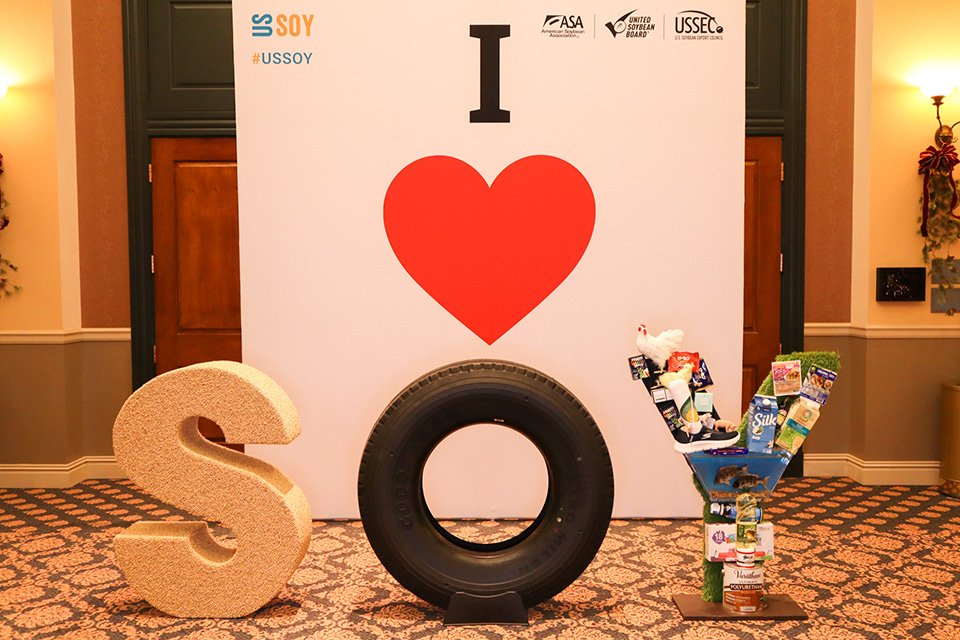
(Photo: U.S. Soybean Export Council)
Communicating science, diversifying markets and differentiating U.S. soy
December 14, 2023 | Aaron Putze, APR
More than 150 soybean farmers representing nearly half-a-million U.S. soybean growers gathered in St. Charles, Mo., Dec. 5-7 for American Soybean Association (ASA) and United Soybean Board (USB) meetings.
Attendees received financial reports and issue updates and conducted leadership elections. Two Iowans were tabbed for national posts. April Hemmes of Hampton was re-elected to the USB executive committee. Dave Walton of Wilton was elected ASA treasurer.
The USB introduced Lucas Lentsch as its incoming CEO. Lentsch currently serves as executive vice president on the Dairy Management Inc. leadership team. He will officially begin his duties as the head of the national soy checkoff organization on Jan. 1.
“Lucas is the right leader at the right time to continue the meaningful work of the soy checkoff and fulfill our vision of delivering sustainable soy solutions to every life, every day,” said Meagan Kaiser, past USB chair. “He is a true thought leader and collaborator with a wealth of checkoff program knowledge and deep agricultural roots.”
Lentsch replaces Polly Ruhland who announced her departure as USB CEO earlier this year. She’s lead USB for the past six years.
Numerous keynote sessions and panel discussions were held throughout the three-day meeting. Key take-aways shared by speakers included:
Greg Tyler, president and CEO, U.S. Poultry & Egg Export Council
- “Sixty percent of domestic soybean meal is consumed by the poultry industry… chicken, turkey, duck and eggs. We’re always looking for new market opportunities, thanks in large part to the support of the U.S. soybean industry.”
- “We normally export $925 million just in chicken paws to the Chinese market at more than $3 pound. If we don’t have that market, they are rendered into pet food at 8 cents per pound.”
Meagan Kaiser, Missouri farmer and past USB Chair
- “It’s unique and notable that as a large board, we’ve worked on developing our strategic direction to drive our investments. We put out big lofty goals at the start of every year and have an ambitious staff that helps accomplish them.”
Kip Tom, former U.S. ambassador to the United Nations Agencies for Food & Agriculture
- “Communication about science is just as important as the science itself.”
- “Half the world can afford the food they eat, the rest cannot.”
- “Wherever there is food insecurity, we tend to have a national security threat.”
- “The European Green Deal is an indulgence of the rich; it is scientifically indefensible and morally indefensible.”
- “Mexico plans to ban glyphosate and imports of biotech corn for human consumption by next year. As a result, the average cost of corn in the country is expected to increase 19%.”
- “Food is power. If you don’t have food, the world becomes very unstable.”
- “To maintain national power, we must have food security. Foundational to food security: the best waterways, the best land, the right people (skilled population) and uninterrupted cultivation with geographical security.”
- “American food power is why we have food security and national security. National power is food. Without food, you can’t do much of anything.”
- “U.S. ag exports are slumping. I hope Sec. Vilsack puts on his selling shoes and hits the road.”
- “There is an infrastructure investment gap of nearly $2.6 trillion this decade. If unaddressed, could cost the U.S. $10 trillion in lost GDP by 2039.”
- “Infrastructure is critical and should be a top priority of the United Soybean Board, followed closely by having conversations with the 98% of Americans who are not involved in agriculture.”
Jim Sutter, CEO, U.S. Soybean Export Council (USSEC)
- “Diversification a key strategy of USSEC.”
- “It was 1956 when the soybean industry opened its first international marketing office. It was the vision of people like soy farmers who saw the need to diversify from just local markets to international markets. Many new markets have opened since, with China a key one in 1982. In 1995, China started to import a little bit of soy. Today, China is the largest importer of soy in the world. Nearly 60% of international soy trade ends up in China.”
- “Three key strategic goals remain for USSEC: attain market access, differentiate U.S. soy and increase preference for U.S. soy.”
- “We diversify markets by focusing on three markets: emerging, mature and expansion.”
John Hinners, VP of Industry Relations, U.S. Meat Export Federation
- “With every U.S. pork export, we’re also exporting pounds of soybeans. For every pork loin, it’s 6 pounds of soy.”
- “We must bring back profitability to the pork industry because when we do, it brings profits back to the soybean farmer and that keeps our rural communities strong.”
Back